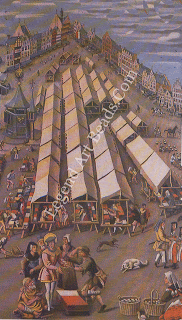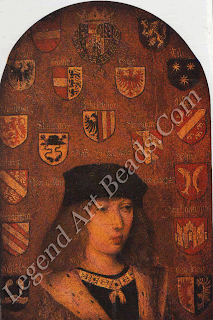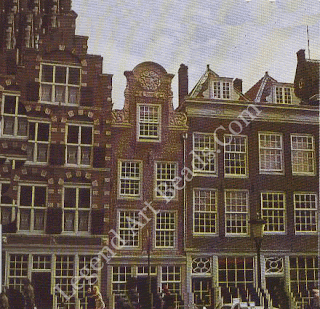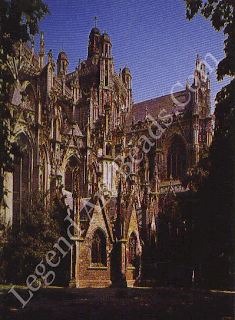Hieronymus bosch
One of the most intriguing artists of
the late middle Ages was Hieronymus Bosch, whose horrific visions of Hell are
some of the most graphic ever painted. Through an art rich in strange and
disturbing images, Bosch reflected the concerns of an age which was everywhere
dominated by religion and death. His mysterious paintings emerge as complex,
moralistic allegories, intended to point out to men the error of their ways.
Yet perhaps the greatest mystery is
Bosch himself. Apart from a few details, little is known about his life. What
is clear is that he spent virtually all of his life in the Netherlandish town
off’s Hertogenbosch, near what is now the Dutch/Belgian border and that during
his lifetime his paintings were well-known, and much admired. Even today, his
paintings continue to fascinate, as they do to baffle, all those who see them.
The Master of’s-Hertogenbosch
A successful and established artist
in his own day, Bosch was a great master of fantasy whose source of inspiration
may be related to the religious atmosphere of his home town.
 Jheronimous Anthonissen van Aken, or
'Hieronymus Bosch' as he signed his paintings, was born about 1450
at’s-Hertogenbosch, a lively and prosperous city in the province of North
Brabant in the Netherlands. The family name suggests that Bosch's ancestors
came from Aachen in North Germany, but they were certainly living in Holland by
the early fifteenth century. Bosch's father, Anthonius van Aken, was a painter,
as were his sister, one of his two brothers, four of his uncles, and his
grandfather Jan. It was possibly to distinguish himself from the rest of his
family that he adopted the pseudonym 'Bosch', taken from the last syllable of
the city's name. Or it may be that he called himself Bosch when he left his
native city and made a trip abroad.
Jheronimous Anthonissen van Aken, or
'Hieronymus Bosch' as he signed his paintings, was born about 1450
at’s-Hertogenbosch, a lively and prosperous city in the province of North
Brabant in the Netherlands. The family name suggests that Bosch's ancestors
came from Aachen in North Germany, but they were certainly living in Holland by
the early fifteenth century. Bosch's father, Anthonius van Aken, was a painter,
as were his sister, one of his two brothers, four of his uncles, and his
grandfather Jan. It was possibly to distinguish himself from the rest of his
family that he adopted the pseudonym 'Bosch', taken from the last syllable of
the city's name. Or it may be that he called himself Bosch when he left his
native city and made a trip abroad.
A DUTCH PROVINCIAL CITY
Although Bosch's childhood remains
some-thing of a mystery, it can be assumed that he had a comfortable,
upper-middle-class upbringing in which religious and artistic matters were of
paramount importance. His family had close connections with the city's
Cathedral of St John. A fresco there, depicting the Crucifixion, and dated
1444, is believed to have been painted by Bosch's grandfather. And his father
received commissions for the decoration of church furniture and the colouring
of statues. It is known that from 1462, the Aken family were living in a large
house in the city's Grote Market or main square.
THE RELIGIOUS BROTHERHOOD
 One
of the most influential religious societies in’s-Hertogenbosch was the Brethren
of the Common Life, a deeply religious foundation which originated in the 14th
century and became firmly established in’s-Hertogenbosch in the 1420s. And it
is to this society rather than to the Adamites that Bosch's life was devoted.
Inspired by Gerhard Groote, a follower of the great Flemish mystic, Jan van
Ruysbroeck, the Brethren sought to counter the moral corruption of the age by
adopting a purer and more devout form of spirituality known as the Devotio
Moderna . The members of the order dedicated themselves to God by renouncing
the world and sharing all that they possessed.
One
of the most influential religious societies in’s-Hertogenbosch was the Brethren
of the Common Life, a deeply religious foundation which originated in the 14th
century and became firmly established in’s-Hertogenbosch in the 1420s. And it
is to this society rather than to the Adamites that Bosch's life was devoted.
Inspired by Gerhard Groote, a follower of the great Flemish mystic, Jan van
Ruysbroeck, the Brethren sought to counter the moral corruption of the age by
adopting a purer and more devout form of spirituality known as the Devotio
Moderna . The members of the order dedicated themselves to God by renouncing
the world and sharing all that they possessed.
By the end of the century, this
foundation had contributed to the steady growth of a number of rival religious
orders in’s-Hertogenbosch It is within this environment, so steeped in
religious experience, that Bosch's mind was shaped. As for his artistic
grounding, it is possible that he had some formal training in a nearby
provincial centre such as Utrecht or, more likely, a that he learnt the
rudiments of his arts in his father's workshop.
 What is clear, however, is that sometime
between 1479 and 1481 Bosch married Aleyt Goyaerts van den Meervenne, who was
quite a few years older than him and came from a wealthy and noble family. She
no doubt provided Bosch with a sizeable dowry and important social contacts.
Through the marriage, Bosch inherited an estate in the nearby village of
Oorschot, as well as several other properties but there were some problems as
in 1481 there seems to have been a quarrel involving a lawsuit between Bosch
and his brother-in-law. Aleyt was, and had been from the age of 16, a member of
the Lieve Vrouve Broederschap, or Brotherhood of Our Lady (both Bosch's father
and grandfather had also been closely involved with its activities).
Established in the early 14th century,
What is clear, however, is that sometime
between 1479 and 1481 Bosch married Aleyt Goyaerts van den Meervenne, who was
quite a few years older than him and came from a wealthy and noble family. She
no doubt provided Bosch with a sizeable dowry and important social contacts.
Through the marriage, Bosch inherited an estate in the nearby village of
Oorschot, as well as several other properties but there were some problems as
in 1481 there seems to have been a quarrel involving a lawsuit between Bosch
and his brother-in-law. Aleyt was, and had been from the age of 16, a member of
the Lieve Vrouve Broederschap, or Brotherhood of Our Lady (both Bosch's father
and grandfather had also been closely involved with its activities).
Established in the early 14th century,

The Brotherhood of Our Lady was a lay
and religious confraternity for men and women which involved itself in a wide
range of affairs including arranging music for their daily masses and
commissioning works of art. It had its own chapel in St John's, where an image
of the Virgin - reputed to have miraculous powers - was kept. Wealthy, devout
and exclusive as it was the brotherhood's influence within’s-Hertogenbosch was
considerable. And it is principally from the Brotherhood's records that the
scanty details of Bosch's personal life are known. In 1480/81, the records show
that Boschbought two altar panels from the Brotherhood which, on the death of
his father, had been left unfinished, probably with the intention of completing
them himself. Later, between 1488 and 1492, Bosch was painting the shutters for
a wooden altarpiece of Our Lady, the central panel of which had been carved in
1476/7 by the famous Utrecht an sculptor Adriaen van Wesel. Some estimation of
Bosch's standing is indicated by the fact that in 1486 he was accepted as a
Gezworen Broeder or 'sworn brother'.
COMMISSIONED WORK
In 1493/4, the Brotherhood
commissioned Bosch to make designs for the stained-glass window in the chapel.
These were executed; it seems, on 'a pair of old bed sheets'. Between 1499 and
1503, the records are curiously silent about Bosch, and it has been suggested
that he may have travelled to Italy during these years. 8 By the turn of the
century, Bosch's work was
Well-known and highly regarded. In
1504 he received his most important documented com-mission. Philip the Fair,
Duke of Burgundy, asked Bosch for a large altarpiece portraying the Last Judgment,
with scenes of Heaven and Hell on each side respectively. Unfortunately, this
work has not been discovered, though some believe that The Last Judgment
fragment in Munich may be part of it, and the The Last Judgment triptych in
Vienna is a smaller version.
THE LAST YEARS
Towards the end of his life, Bosch
was working regularly on commissions for the Brotherhood. In 1508/9 he advised
on the decoration of an altarpiece of Our Lady and further commissions followed
designs for a crucifix in 1511/12, and a brass chandelier in 1512/13. Bosch
died in 1516, less than 10 years before the birth of Pieter Bruegel his natural
successor in artistic terms. The notices of his death refer to him as insignis Pictor
(illustrious painter) and seer vermaerd schilder (very famous painter), a final
tribute to his qualities as an artist of diverse and prodigious talents.
Writer - Marshall Cavendish
 Jheronimous Anthonissen van Aken, or
'Hieronymus Bosch' as he signed his paintings, was born about 1450
at’s-Hertogenbosch, a lively and prosperous city in the province of North
Brabant in the Netherlands. The family name suggests that Bosch's ancestors
came from Aachen in North Germany, but they were certainly living in Holland by
the early fifteenth century. Bosch's father, Anthonius van Aken, was a painter,
as were his sister, one of his two brothers, four of his uncles, and his
grandfather Jan. It was possibly to distinguish himself from the rest of his
family that he adopted the pseudonym 'Bosch', taken from the last syllable of
the city's name. Or it may be that he called himself Bosch when he left his
native city and made a trip abroad.
Jheronimous Anthonissen van Aken, or
'Hieronymus Bosch' as he signed his paintings, was born about 1450
at’s-Hertogenbosch, a lively and prosperous city in the province of North
Brabant in the Netherlands. The family name suggests that Bosch's ancestors
came from Aachen in North Germany, but they were certainly living in Holland by
the early fifteenth century. Bosch's father, Anthonius van Aken, was a painter,
as were his sister, one of his two brothers, four of his uncles, and his
grandfather Jan. It was possibly to distinguish himself from the rest of his
family that he adopted the pseudonym 'Bosch', taken from the last syllable of
the city's name. Or it may be that he called himself Bosch when he left his
native city and made a trip abroad.  One
of the most influential religious societies in’s-Hertogenbosch was the Brethren
of the Common Life, a deeply religious foundation which originated in the 14th
century and became firmly established in’s-Hertogenbosch in the 1420s. And it
is to this society rather than to the Adamites that Bosch's life was devoted.
Inspired by Gerhard Groote, a follower of the great Flemish mystic, Jan van
Ruysbroeck, the Brethren sought to counter the moral corruption of the age by
adopting a purer and more devout form of spirituality known as the Devotio
Moderna . The members of the order dedicated themselves to God by renouncing
the world and sharing all that they possessed.
One
of the most influential religious societies in’s-Hertogenbosch was the Brethren
of the Common Life, a deeply religious foundation which originated in the 14th
century and became firmly established in’s-Hertogenbosch in the 1420s. And it
is to this society rather than to the Adamites that Bosch's life was devoted.
Inspired by Gerhard Groote, a follower of the great Flemish mystic, Jan van
Ruysbroeck, the Brethren sought to counter the moral corruption of the age by
adopting a purer and more devout form of spirituality known as the Devotio
Moderna . The members of the order dedicated themselves to God by renouncing
the world and sharing all that they possessed. What is clear, however, is that sometime
between 1479 and 1481 Bosch married Aleyt Goyaerts van den Meervenne, who was
quite a few years older than him and came from a wealthy and noble family. She
no doubt provided Bosch with a sizeable dowry and important social contacts.
Through the marriage, Bosch inherited an estate in the nearby village of
Oorschot, as well as several other properties but there were some problems as
in 1481 there seems to have been a quarrel involving a lawsuit between Bosch
and his brother-in-law. Aleyt was, and had been from the age of 16, a member of
the Lieve Vrouve Broederschap, or Brotherhood of Our Lady (both Bosch's father
and grandfather had also been closely involved with its activities).
Established in the early 14th century,
What is clear, however, is that sometime
between 1479 and 1481 Bosch married Aleyt Goyaerts van den Meervenne, who was
quite a few years older than him and came from a wealthy and noble family. She
no doubt provided Bosch with a sizeable dowry and important social contacts.
Through the marriage, Bosch inherited an estate in the nearby village of
Oorschot, as well as several other properties but there were some problems as
in 1481 there seems to have been a quarrel involving a lawsuit between Bosch
and his brother-in-law. Aleyt was, and had been from the age of 16, a member of
the Lieve Vrouve Broederschap, or Brotherhood of Our Lady (both Bosch's father
and grandfather had also been closely involved with its activities).
Established in the early 14th century, 















0 Response to "Introduction to Hieronymus Bosch"
Post a Comment